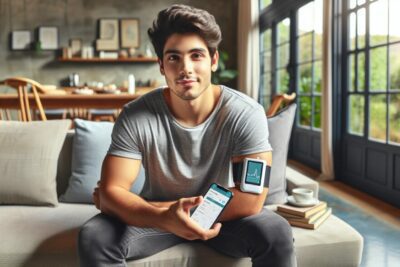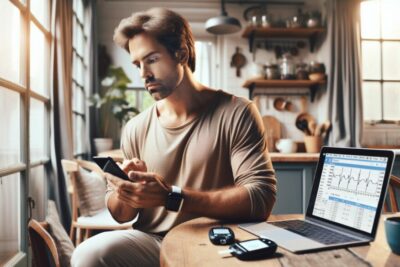
Understanding the proper placement for your Dexcom ONE sensor is crucial to ensure accurate glucose readings and comfort. If you're wondering, "Is this placement ok for Dexcom ONE sensor?" you are not alone. Many users seek the best practices for sensor positioning to optimize their Continuous Glucose Monitoring (CGM) experience.
For those managing diabetes, the Dexcom ONE offers a convenient way to monitor glucose levels. However, the success of this technology largely depends on the correct placement of the sensor. Let's explore the recommended sites and tips for sensor application to empower your glucose management journey.
🔍 Seeking a breakthrough in Type 2 Diabetes management?
Discover our expert insights and innovative approaches on ‘How to Cure Diabetes’.
Click to transform your health journey today!
What you\'ll find in this article?
- Where do I insert my Dexcom ONE sensor?
- What are the best areas to insert the Dexcom ONE sensor?
- How do I properly place my Dexcom ONE sensor?
- Can I use my Dexcom ONE sensor on my thigh?
- What should I consider when inserting a Dexcom ONE sensor?
- How can I ensure my Dexcom ONE sensor stays attached?
- What are the recommended locations for Dexcom G6 sensor placement?
- Questions Related to Dexcom ONE Sensor Placement
Where do I insert my Dexcom ONE sensor?
When it comes to inserting your Dexcom ONE sensor, choosing the right spot is paramount. The abdomen and the back of the upper arms are the two primary areas recommended for adults and children over the age of six. For young children between the ages of two and six, the upper buttocks may also be used, provided there is enough fatty tissue.
It is important to avoid areas with frequent movement, scars, or tattoos, as these can affect sensor performance. Also, rotating the insertion sites is recommended to allow the skin to heal and prevent irritation.
Choosing a site with sufficient fatty tissue is essential for optimal sensor performance.








Explore our specialized services in diabetes care 🌟.
From personalized diet plans to effective exercise routines, we have what you need to take control of Type 2 Diabetes.
Visit our services page now!
What are the best areas to insert the Dexcom ONE sensor?
Identifying the best areas for your Dexcom ONE sensor involves considering both comfort and accuracy. The manufacturer's guidelines suggest the aforementioned areas for good reason, as they typically provide a stable environment for the sensor to do its job effectively.
Users have reported experimenting with different sites; however, it is important to note that these alternative placements are not officially recommended and may affect the accuracy of readings.
Consulting healthcare professionals for personalized recommendations before trying new insertion sites is always advised.
How do I properly place my Dexcom ONE sensor?
Proper placement of your Dexcom ONE sensor not only involves selecting the right spot but also following the application technique precisely. Begin by cleaning the chosen area with alcohol wipes and letting it dry completely. Then, follow the step-by-step instructions provided by Dexcom to insert the sensor. Ensuring the skin is free of lotions or oils before application will help in improving sensor adhesion.
Many users find it helpful to watch tutorial videos or seek assistance for the first few applications until they become familiar with the process.
Following the manufacturer's instructions closely is key to a successful and accurate sensor placement.
Can I use my Dexcom ONE sensor on my thigh?
While some users have experimented with placing the Dexcom ONE sensor on the thigh, it is important to understand that this is not an officially approved site. The areas that have been tested and approved are the abdomen, the upper arms, and, for younger children, the upper buttocks. Unapproved sites may yield inaccurate results and are not recommended.
Individuals who have tested the thigh site often share mixed results, indicating that it's best to stick to the recommended areas or discuss alternatives with a healthcare provider.
What should I consider when inserting a Dexcom ONE sensor?
When inserting your Dexcom ONE sensor, consider factors like your daily activities, wardrobe choices, and your sleep habits. The sensor should be placed in an area where it is least likely to be disturbed or subjected to pressure while sleeping or moving.
Avoiding areas that will be constricted by tight clothing, belts, or waistbands can help maintain sensor integrity and comfort. Also, take into account your body's natural curves and contours to ensure the sensor stays in place during various activities.
How can I ensure my Dexcom ONE sensor stays attached?
- Ensure the skin is clean and dry before applying the sensor.
- Consider using a barrier wipe or patch to increase adhesion if you have sensitive skin or are prone to sweating.
- Check the sensor regularly and smooth down any lifted edges.
- Use overlay patches or tapes designed for CGM sensors to provide extra security.
Taking these steps can help to ensure your sensor remains secure between replacements.
What are the recommended locations for Dexcom G6 sensor placement?
The Dexcom G6, although a different model, shares similar recommended placement areas with the Dexcom ONE. The abdomen and the back of the upper arms are the primary sites for adults and children over the age of two. The manufacturer emphasizes these locations for accuracy and safety.
Where are the acceptable sites for Dexcom?
The acceptable sites for the Dexcom sensors, including Dexcom ONE, are the abdomen and the back of the upper arms. These areas are chosen for their consistency in providing accurate glucose readings.
Due to the sensor's need for a stable environment, it is best to follow the guidelines and avoid experimenting with unapproved sites.
Does Dexcom placement matter?
Yes, Dexcom sensor placement matters significantly. The location can influence the accuracy of glucose readings and the duration the sensor stays in place. Proper placement ensures that the sensor properly monitors glucose levels and provides reliable data.
Where should the Dexcom sensor be placed?
The Dexcom sensor should generally be placed on the abdomen or the back of the upper arms. These locations are recommended by the manufacturer and have been clinically tested to provide accurate and reliable glucose monitoring.
Where can I put my Dexcom on my stomach?
When placing your Dexcom on your stomach, aim for an area that is at least two inches away from the belly button and not over any scars or irritated skin. It's also wise to rotate the sites to prevent skin irritation.
By following these guidelines for Dexcom ONE sensor placement, users can ensure they are getting the most accurate readings and the most comfortable experience. Remember, when in doubt, consult with a healthcare professional to get advice tailored to your unique needs and circumstances.
✨ Other articles you might be interested in:
- EAG/A1C Conversion Calculator: Understanding Your Blood Sugar Levels
- Understanding Insulin Pens | ADA's Guide to Usage and Selection
- Understanding Insulin Pumps: Relief and Choice for Diabetics
- Exploring the Craft at Pens and Needles Tattoo Parlors
- Choosing a CGM: A Guide to Glucose Monitors Endorsed by ADA



